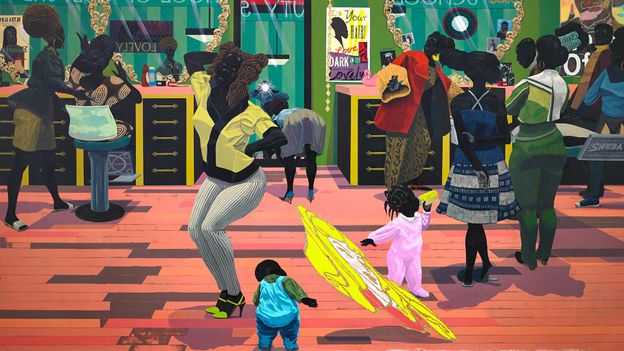Exploring Kerry James Marshall’s “School of Beauty, School of Culture”
Kerry James Marshall’s artwork often serves as a vibrant tapestry that intertwines themes from art history with contemporary black culture, creating layers of meaning and connection for viewers. His piece “School of Beauty, School of Culture” is a prime example, utilizing references that not only pay homage to past masters but also delve into the nuances of identity and representation.
Reflections of Art History
One of the most compelling aspects of “School of Beauty, School of Culture” is how it draws inspiration from historical masterpieces, particularly Jan van Eyck’s Arnolfini Portrait (1434) and Diego Velázquez’s Las Meninas (1656). Marshall scatters mirrors throughout the salon setting of his painting, echoing the reflective elements utilized in these iconic works.
In Van Eyck’s painting, a convex mirror expands the viewer’s perspective, inviting them to engage with the broader context of the domestic scene. Conversely, Velázquez’s strategic placement of a mirror also serves a dual purpose: it reveals the reflections of King Philip IV and Queen Mariana, blurring the lines between observer and observed. Marshall incorporates a modern twist; as the central figure poses for the viewer, a camera flash appears in the reflection, connecting contemporary photography with classical painting techniques. This interplay of reflection not only enriches the narrative but also prompts a dialogue about visibility and representation in art.
Contemporary Cultural Nods
Marshall doesn’t stop at historical references; he seamlessly integrates elements of contemporary black culture into his salon. Prominently featured are signed posters of influential figures, such as Lauryn Hill and Chris Ofili, whose work contributed significantly to the discourse around black identity in art. At the time of Ofili’s celebrated 2010 exhibition at Tate Britain, he was widely acknowledged as a leading figure in British art, known for his rich, textured paintings that resonate with cultural depth.
Marshall’s recollections of first encountering Ofili’s work reveal a deep respect and admiration. “They were the best paintings I’d ever seen because they were rich, complex, and layered,” he comments, reinforcing Ofili’s stature in his eyes and the broader art community. This layering of references creates a tapestry that reflects both the personal and collective narratives within the black experience.
The Genius of Mixing References
Art critic Godfrey highlights what makes Marshall’s work so compelling: his ability to navigate the complex terrain of art history and popular culture. By drawing on the techniques of masters like Raphael and Holbein while simultaneously referencing contemporary artists and musicians like Lauryn Hill, Marshall crafts art that resonates across time. This blending reflects not only Marshall’s scholarly knowledge of painting but also his lived experience in the world, serving as a bridge between the historical and the modern.
The Representation of Black Identity
At the heart of “School of Beauty, School of Culture” lies a crucial aspect of Marshall’s artistic vision: the portrayal of black figures. Each individual in the salon is depicted in deep shades of black, an intentional choice that compels viewers to confront the representation—or often the absence—of black bodies in large-scale art. Godfrey explains that in the ’60s and ’70s, particularly in the United States, the capitalization of “Black” became a symbol of pride and identity. Marshall’s decision to paint figures that are explicitly and beautifully black acts as a reclamation of this identity, asserting their place within the canon of art history.
By placing black figures central to the narrative of his piece, Marshall challenges the traditional norms of representation in art. His work compels viewers to reflect on the visibility of black people within the art world, encouraging a re-evaluation of the historical narratives and an invitation to appreciate the richness of black experiences portrayed in his work.
Kerry James Marshall’s “School of Beauty, School of Culture” stands as a dynamic exploration of identity, culture, and the ties that bind contemporary life to the historical narratives of art. Through mirrors reflecting past masterpieces, nods to modern cultural figures, and the bold representation of black identities, Marshall constructs a space that is both familiar and profoundly transformative.



